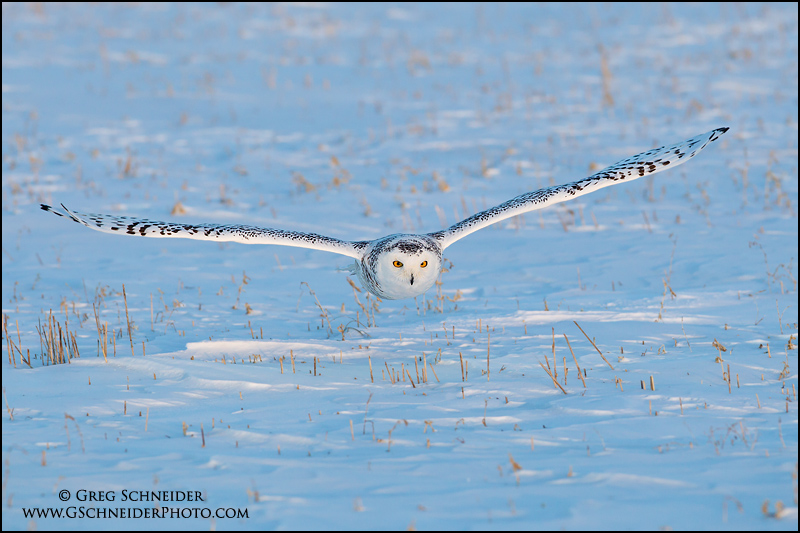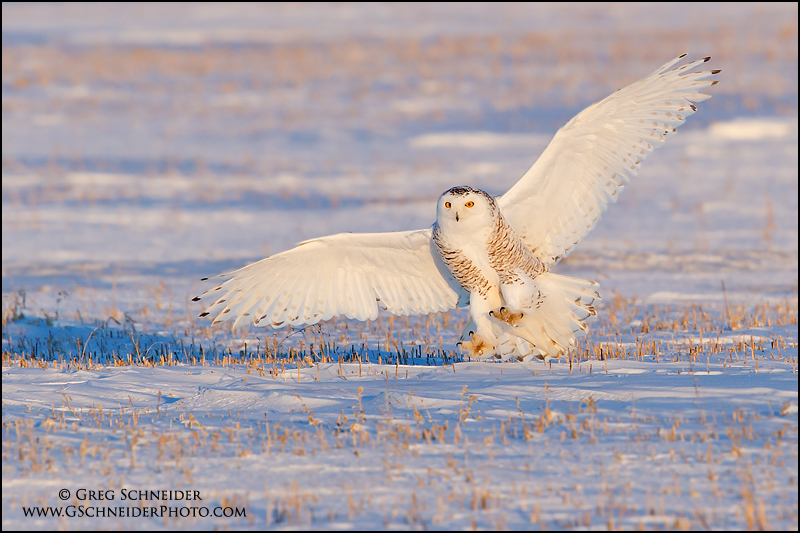Tagged: bif
Snowy Owls in sweet light
I’ve added two more images of snowy owls from last winter, photographed here in Ontario, Canada. I have many more photos to go through. I really liked the light on both of these, and it was great to have this co-operative female snowy to photograph as she hunted.
Canon 7D Review – Part 2: Field Test
I managed to take the 7D out for a few hours of test shooting. With few subjects around I couldn’t test the AF to the limits, but had several opportunities with birds in flight. I will add more samples in the weeks to come to illustrate the image quality a bit further, both at high ISOs and hopefully some extended tracking sequences to show the AF capability.
Battery life
What immediately struck me was that despite using the same battery as the 5D Mark II, the 7D appears to be more power efficient. It should be quite possible to achieve 1200+ shots per battery, compared to a maximum of about 800-1000 in my experience with the 5D II (I’m extrapolating a bit, so YMMV). Needless to say, battery life won’t be an issue unless you shoot video or review images a lot, and the 7D offers respectable battery life even if it can’t quite touch the 1D which gets to 2000-3000+.
Autofocus
With few ducks around I had to rely on gulls to test the AF on birds in flight, which admittedly aren’t quite as challenging as small, fast flying ducks. The 7D seemed to track beautifully, even against busy backgrounds the zone and 19 point AF would track well, as long as there was enough contrast between the bird and the background and the bird wasn’t too small in the frame. Of course, this type of shooting is much better suited to the single point AF selection mode.
One new feature on the 7D is that it’s now possible to have the camera display the AF point it has selected when shooting in AI Servo and not manually selecting a point. It’s a great addition and allows you to confirm what the AF is tracking and gives valuable feedback to the photographer.
Overall the focusing felt similar to the 1D III, about the same in acquisition speed and I’d say even better in tracking, as surprising as that may sound. The extra AF modes also allow for more flexibility, and I think the zone AF mode will be more useful than single point + expansion for birds in flight against a clean background, simply because you don’t have to keep the AF point right on the bird and it gives more room for error. Using all 19 points seems to be much more effective than using all 45 on the 1D, The one noticeable difference is that when acquiring a target that’s really out of focus, the AF will search for a subject, but often not long enough to actually acquire the subject, or it may lock on while still very misfocused. This is similar to my experience with other prosumer bodies, while only the 1D tends to search for focus long enough to accurately acquire a grossly out of focus target. In practise this is probably not a significant concern.
Operation
The body feels fast overall, with a more muted shutter sound than the 1D, but shooting at nearly the same speed. The new ergonomic enhancements are a great addition and the body feels great in the hand, even without a grip. By comparison the 5D II feels much more cheaply built and the combination of the shutter sound and burst rate contribute to feeling of it being a lower-class camera. In addition, the viewfinder feels similar to the 5D II or 1D III, despite the smaller sensor and increased crop factor and is a joy to use, especially with the extra spacing between the viewfinder and the LCD (as with the 1D), leaving a bit more room for your nose!
While the 1.6x crop factor can cause issues with framing being too tight at times, it’s a great help for wildlife under most conditions, where you are typically always in need of more focal length. I had forgotten how nice it was to have a 1.6x FOV when shooting birds, and with 18MP, the ability to put many pixels on a bird is not to be dismissed.
White Balance & Metering
The white balance mode seems to have been significantly improved. I often get results in automatic WB (AWB) that look similar to what I usually use cloudy WB (for warmer colour temperatures) on my other bodies. This can take some getting used to as it’s now possible to rely much more on AWB. Metering has been revamped with the iFCL system and more metering zones. While it is more intelligent than before, one still has to apply correction, especially if there are white highlights in a small portion of the frame, particularly with the rest of the frame being darker in tone. However, this is to be expected from any metering system that uses most of the frame to calculate exposure, and can’t really be attributed as a flaw. For more consistent results, spot metering would work best under those circumstances.
Sample Images
These are all unprocessed images, uncropped and straight out of the camera as JPEGs.
Herring Gull - 800mm f7.1 ISO400 (those are water ripples and not banding!)
Northern Cardinal - 800mm 1/320 f5.6 ISO800
Black-Capped Chickadee - 800mm 1/250 f5.6 ISO800
Green-Winged Teal - 800mm 1/640 f7.1 ISO400
The noise levels and detail at ISO800 are still extremely good. I would be hard pressed to say the 1D Mark III is much better once the filesizes are equalized for a proper 1:1 comparison. In bird photography, typically when you need extreme ISO (3200+), the light quality isn’t worth shooting in, but I will try to post some real world very high ISO samples soon.
Overall I’m very pleased with the image quality of the 7D. While the results are not quite as good as what a larger sensor would give you, I think the reputation it already has for being the lowest noise crop body is well deserved. While there certainly is noise, it’s nicely controlled and in a pleasing pattern, with no banding to be seen. This also makes it very easy to clean up. The 18MP resolution also gives a lot of flexibility for cropping or printing large prints, and this is especially useful for wildlife photography when you are often cropping. It’s clear to see that especially with an excellent lens attached, fine detail is superb and these files can be heavily cropped.
Closing Thoughts
The 7D delivers a punch in a smaller package, with performance not too far off that of the much larger and more expensive 1D series. I could see this becoming the body of choice for anyone into bird or wildlife photography, and particularly for those who want to save money over the pro bodies but still enjoy excellent performance. I only wish Canon would use the 5D II sensor in a 7D body; as good as the 7D is, a full frame sensor will always have the image quality edge, and having a full frame, high resolution small-bodied camera would be fantastic, with the major detriment of the 5D II being its autofocus and less than professional class body . That said, having both the 5D II and the 7D in your bag would be hard to beat, and ably cover all applications from landscapes to birds. I foresee myself using the 7D for focal length limited situations, such as more distant waterfowl and small songbirds, when the light is good. I do look forward to what the 1D III’s successor brings, and will probably use that as my primary body with the 7D as backup, or when pixel density is of concern.

